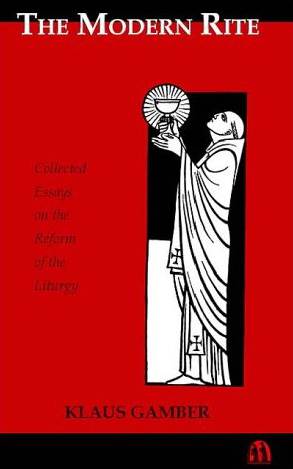 Msgr. Klaus Gamber skriver i sin essaysamling «The Modern Rite» om tanken om at presten bør vende seg mot folket:
Msgr. Klaus Gamber skriver i sin essaysamling «The Modern Rite» om tanken om at presten bør vende seg mot folket:
In his «‘Guidelines for the Layout and Arrangements of a Church in the Spirit of the Roman Liturgy,» in 1949, Theodor Klauser says (no. 8) that: «There are many indications that in church buildings of the future the priest will once more stand behind the altar, as he did formerly, and will celebrate Mass facing towards the people, just as is still done in the Roman basilicas; the desire, which is felt everywhere, to have the eucharistic fellowship more clearly expressed by gathering round the table, seems to favour this solution.»
What Klauser, in his day, posited as a desirable development, has in the meantime become widely regarded as the norm. People are almost all of the opinion that they have thereby restored an early Christian custom. But is this in fact really so? …
På de 40 åra som er gått siden msgr. Gamber skrev dette, er denne tanken (om at presten i tidligere tider vendte seg mot folket) blitt avvist ganske så grundig, og gjentatte ganger. Men likevel hører jeg prester som også i dag sier hvor viktig det er at presten vender seg mot folk, ser på dem, snakker til dem osv. Er det slik at prestene ikke følger med i den teologiske debatten, eller er det at de ikke ønsker å forandre den praksisen de selv har lært seg, hva er det som gjør at de holder fast på en slik feil forståelse?
Selvsagt skal presten vende seg mot folk i deler av messen, men ikke når de ber til Gud, og msgr. Gamber er ganske klar i sin konklushon i dette kapittelet:
… How are things arranged in the Eastern Church? Here too there was never a time when a celebration «‘turned towards the people» was customary, since there is no explicit witness to it. It is remarkable that in the case of a concelebration, of which there is a long tradition in the Eastern Church, the principal celebrant normally stands with his back to the congregation, while the priests who are concelebrating stand to his right and his left. But at no point do they take up a position behind the altar.
The decisive question, with regard to the position of the priest at the altar, is, as we have already mentioned several times, the character of the Mass as a sacrifice. The person offering the sacrifice turns towards the person to whom the sacrifice is being presented. By early Christian conceptions, one did this by turning to look towards the east. …
… One can best do justice to the aspect of the Mass as a sacrifice if, during the Eucharistic Prayer, in the course of which the holy sacrifice is consummated, all the people together with the priest turn in the same direction (that is to say, towards the east). The aspect of a meal, in turn, could be brought out more clearly by the way the ritual of Communion is shaped. We do not need to give any particular explanation here why it is that priest and readers should face the people for the proclamation of the Word of God. …
